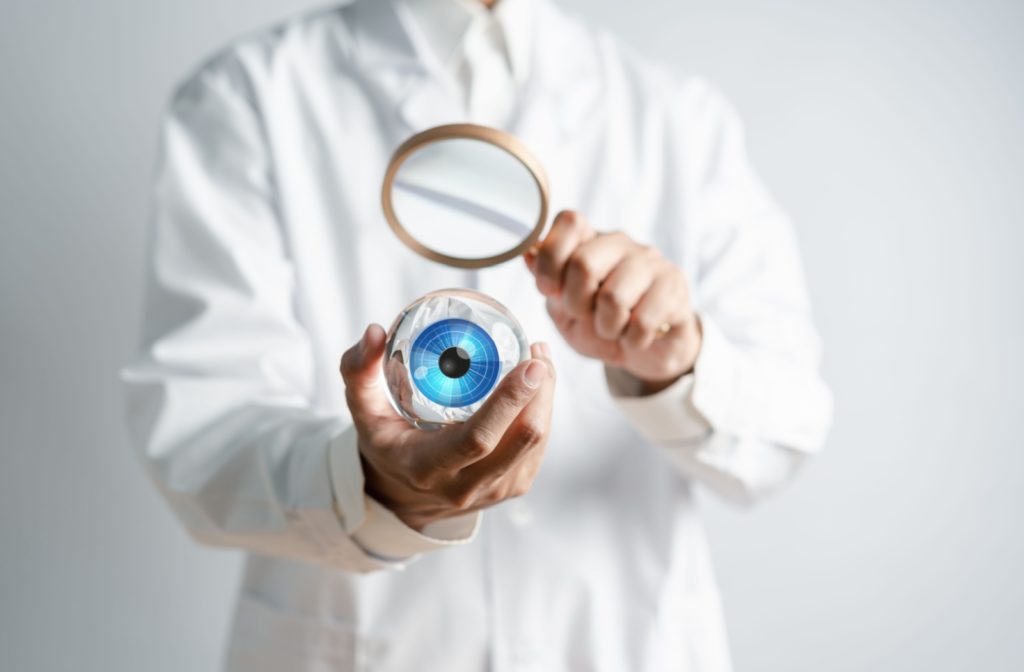Vision changes can make even the simplest activities frustrating—like struggling to read your favourite book or feeling uneasy driving at night. Myopia and astigmatism are some of the most common causes behind this ever-present blurry vision. However, people often confuse them because they share some similar symptoms
Myopia and astigmatism are not the same, but they can overlap and affect your vision in similar ways. Moreover, they require slightly different treatments. Your optometrist can uncover the source of your blurry vision with an eye exam and offer treatments like corrective lenses to make clear vision a reality again.
What Is Myopia?
Myopia, often called nearsightedness, is the most common refractive error that impacts how the eye focuses light. Normally, light enters the eye through the clear front part (the cornea) and the lens, focusing on the retina, a layer at the back of the eye that processes images. This lets us see things clearly.
But, in people with myopia, the eyeball is slightly longer than normal, or the cornea is more curved than it should be. This causes light to focus in front of the retina instead of directly on it, making faraway objects look blurry, while close-up objects stay clear.
Myopia typically first appears in children and often worsens as they age before stabilizing once they become adults. Common myopia symptoms include:
- Blurry vision when looking at distant objects
- Squinting or straining to see clearly
- Eye fatigue or discomfort after prolonged focus on distant objects
- Difficulty seeing road signs, whiteboards, or similar faraway details
Myopia can affect anyone but is often linked to genetic factors or long periods of time spent focusing on nearby objects, such as reading or using screens.
What Is Astigmatism?
Astigmatism occurs when the shape of the cornea or lens of the eye is irregular, preventing light from focusing properly on the retina. A healthy cornea is evenly curved, helping focus light properly onto the back of the eye so we can see clearly. But with astigmatism, the cornea’s uneven shape bends light differently, which can cause blurry or distorted vision. This results in blurry, distorted, or fuzzy vision at any distance.
Unlike myopia, where the eye is longer from the front to back (the axial length), astigmatism can cause the normally circular eye to be shaped more like an oval.

There are 2 main types of astigmatism:
- Corneal astigmatism: This type occurs when the cornea, the clear front surface of the eye, has an irregular curve.
- Lenticular astigmatism: This type happens when the lens inside the eye has an irregular shape.
Additionally, astigmatism can be classified as regular, where the curvature is evenly placed but still abnormal, or irregular, where the curvature is unevenly placed and more erratic.
Other than blurry vision, symptoms of astigmatism can vary but often include:
- Difficulty seeing at night
- Eye strain or discomfort
- Headaches
- Double vision
- Light sensitivity
Comparing Myopia & Astigmatism
While both myopia and astigmatism result in blurry vision, the difference lies in how and when blurred vision appears.
- Myopia: Objects in the distance appear blurry, while nearby objects are clear.
- Astigmatism: Blurriness or distortion can occur at all distances.
Perhaps more importantly, it’s not uncommon for these two conditions to overlap. Many people experience both myopia and astigmatism simultaneously, which can make vision issues feel more complex.
Eye doctors typically diagnose both conditions during a comprehensive exam, using tools like a phoropter and retinoscope to measure how light enters and focuses in your eyes.
How an Optometrist Can Help Treat Refractive Errors
You don’t have to guess what’s causing your blurry vision. During an eye exam, optometrists can determine exactly what’s going on with your eyes and recommend a solution suited for you. This might mean prescription glasses or contact lenses to correct the irregular shape of your cornea or lens, giving you clearer, sharper vision that’s perfectly tailored to your prescription.
If you’re looking for a more long-term fix, your optometrist can also see if laser eye surgery, like LASIK, is a good option for you and guide you through the process. They can even share tips on how to reduce eye strain and keep your eyes healthy day-to-day.
Myopia Control for Children
We are seeing a rise in myopia among kids. When left unmanaged, myopia worsens over time, leading to stronger prescriptions and increasing the risk of eye problems like retinal issues or glaucoma. Fortunately, Optometrists can slow myopia progression with myopia control.
The earlier we diagnose it with an eye exam, the more we can do to address its effects. Management plans may include specialty lenses or contacts that cue the eye to stop growing, limiting the damage myopia can do.
Clear Vision Starts Today
Whether you’re struggling to see road signs, finding it hard to focus on small text, or experiencing constant headaches, addressing your symptoms with the right treatment can make all the difference.At Pinehouse Eyecare, our expert team is here to help your family take control of your eye health. Book an appointment with us today for a comprehensive eye exam and personalized treatment plan. We’re ready to help you see the world through clearer eyes!










